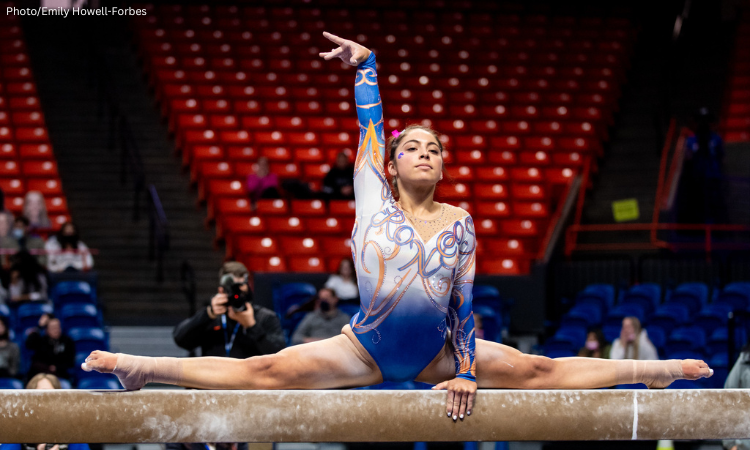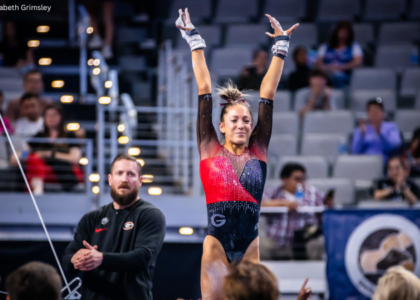December is right around the corner, which means it will soon be drafting season for those planning to participate in fantasy gymnastics on Gymlytics next year. It may be daunting to put together a draft all on your own, especially if this is your first time, but we’re here to help. We put together a few sample drafts at this link that you can reference, as well as a tool to help get you started with your own custom draft! Read more about the strategies and themes for each of the sample drafts and experiment with our drafting tool below.
What is the theme of your sample draft, and why did you select it?
Peri: My draft is full of international gymnasts and gymnasts who have competed for any country that’s not the United States. It’s a theme I’ve enjoyed using since I started playing fantasy gym around 2017, and I’m proud of the growing presence Canadian level 10s have established in the draft each year.
Emma: My draft is the ultimate list of consistency queens! I took it over for Jenna this year and I’ve had a lot of fun making it. My “high risk” strategy didn’t work super well for me last year…so I’m taking a different route.
Mariah: My draft includes only athletes from non-Power Five schools. One of my favorite parts about having a fantasy team is discovering underrated gymnasts that I might not hear much about, and this is a whole draft full of them!
What methodology did you use while creating your sample draft?
Peri: At the risk of stating the obvious, the first step was scraping rosters for athletes that aren’t American or have a non-American FIG license. From there I weighted event averages slightly higher than NQS and high scores, since that’s all we’ll have for the first stretch of the season. Athletes who can contribute on three or more events are higher in my draft to ensure I can put up enough routines each week. On the flip side, if a gymnast has a standout event (typically over 9.875) they were bumped up too—once I know I have six to eight routines going up, I need some big numbers to even out any hiccups.
Emma: I narrowed my draft down to those with an average of 9.7-plus on any event. As a data person, I used four main factors to make a ranking algorithm for my draft: average difference between NQS and average, events competed, average high score, and NQS averaged. I then normalized these to the data set (making sure everything is distributed equally), and multiplied those quantities by a weight of importance. This gave me a score to work off of, then I used last year’s draft rankings and raw scores to manually sort where the algorithm lacked.
Mariah: For the most part everyone included on my draft list has an NQS of 9.8-plus and an average of 9.7-plus on at least one event. I then ranked the gymnasts, taking into account their high, average, and NQS from last season (or the 2022 season if they didn’t compete last season). I prioritized the amount of high scoring routines an athlete could contribute and also sprinkled in a few promising freshmen. Since there are no star all-arounders with 9.95-plus scoring potential on every event in this draft, it may seem a bit riskier than a standard draft because it relies more on two- and three-eventers with high scoring potential versus all-arounders, but I think those are the kind of athletes that highlight the non-Power Five conferences best anyway.
Who is the No. 1 pick in your sample draft? Who else did you consider for that spot, and why did you ultimately choose that gymnast?
Peri: Luisa Blanco is at the top of my draft, credit to her consistency and lineup frequency. I’m a very calculated fantasy drafter, and ultimately I need to know that my first few picks can be consistent all-arounders. Right behind her are Aleah Finnegan, Emma Spence, and Hannah Scharf.
Emma: This was a difficult one, as Jade Carey is very clearly the most consistent NCAA gymnast but isn’t slated to compete in the all-around every week because of her elite training. Since we don’t know what events and when she will be competing, I slotted Haleigh Bryant of LSU into the first spot. Her lowest average on any event is just shy of a 9.9, outpacing Jordan Bowers who sits in second. Those two seemed to be picks I would make outright before gambling on Carey, while everyone who fell behind her would be a toss-up depending on the strengths of my team.
Mariah: The top spot in my draft belongs to Emily Lopez at Boise State. Normally I would put an all-arounder in the top spot, but her scoring potential is just too good to overlook. Courtney Blackson, also from Boise State, is second on the list. Both scored perfect 10.0s last season, so I would say they are definitely worth the risk of not drafting an all-arounder.
What would the average gym fan find surprising about your draft? This could be a big name who appeared lower than expected or a hidden gem who’s highly placed.
Peri: As much as I hype up the Canadian presence in collegiate gymnastics, there are plenty of names high in my list from Central America and Europe. Keep an eye out for my highest-ranked freshman, Keira Thornton out of Bowling Green, who is from England. There are also six different conferences represented in my top 10!
Emma: UCLA sophomore Selena Harris is the only underclassman to break my top 10. While still getting adjusted to vault, she boasts a MASSIVE 9.923 average on beam and 9.9-plus averages on the other two events. Mya Lauzon is also a surprise, having jumped from a 197th ranking in our consistency draft last year into a whopping 15th this year!
Mariah: Although my draft is mostly made up of DI athletes, there’s still some representation from Divisions II and III lower down on the list. Most notably, Lexi Castellaneta, formerly of Brockport and now representing Utica in its inaugural season, made the list thanks to her strong floor performances in 2022.
Custom Draft Tool
Aside from the sample drafts above, this year we have also prepared a tool for creating your own custom draft. To create your draft:
- Enter the number of gymnasts you need on your team (team size) and the number of players in your league (league size).
- Choose the primary and secondary metric that you would like to use for sorting gymnasts. Pick from among various career-level and season-level metrics, such as career high or season NQS. When available, season-level metrics are based on the most recent season in which the gymnast earned an NQS on the event. Otherwise, the most recent season in which the gymnast competed on the event is used.
- Choose if and how you would like to discount metrics for newcomers. As they have no college scoring history, metrics have been estimated for these gymnasts based on their recruit ratings. By selecting “None,” the tool will use the estimated metrics as is. If you prefer drafting gymnasts with metrics that are based in college scoring history, you can apply either a blanket discount (estimated metrics are reduced by the same amount for each gymnast for a given event) or a proportional discount (estimated metrics are reduced by a smaller amount for gymnasts with a higher recruit rating).
- Choose what rank after which to stop considering a gymnast’s scoring potential on an event. After sorting the gymnasts, the tool estimates each gymnast’s potential contributions to your team. One factor is the likelihood the gymnast will make their team’s lineup and get to compete. If you think the top six gymnasts based on your chosen sorting metrics will be the six gymnasts who make lineups, you may choose a cutoff of six. But if you would prefer some leeway, you may still want to consider the scoring potential of the seventh-ranked gymnast on an event, for instance.
- Choose how much you would like to prioritize all-around gymnasts as opposed to specialists, as well as gymnasts with more college experience as opposed to newer gymnasts. For example, if you choose to prioritize all-around gymnasts 50% of the time, the tool will look for the next gymnast in your sort order based on metrics across all events in 50% of picks and based on metrics on a single event in the other 50% of picks. Similarly, if you choose to prioritize more experienced gymnasts 75% of the time, when choosing between gymnasts with otherwise similar metrics, the tool will pick the gymnast with more scoring college routines under their belt 75% of the time.
- Lastly, feel free to experiment with themed drafts! The tool allows you to choose the conferences or states that you would like to limit your draft to, if any. You can also choose whether you would like your draft to include transfers only, not include any transfers, or both. Note that the tool will only draft as many gymnasts as meet your chosen criteria.
| Draft Order | Name (Team) | ||||||||
|---|---|---|---|---|---|---|---|---|---|
| VT | UB | BB | FX | VT | UB | BB | FX | ||
READ THIS NEXT: Fantasy Central: A Dataset for 2024 Draft Prep
Article by Dara Tan, Emma Hammerstrom, Peri Goodman, and Mariah Dawson
Interactive tool built by Izzi Baskin





Thank you soooooo much ❤️❤️ how do I import my custom draft into gymlitics?
I’m not sure the B1G and PAC12 conference theme features are functioning. I can’t get them to spit out any data.
We’ll look into this! Thanks for pointing it out.